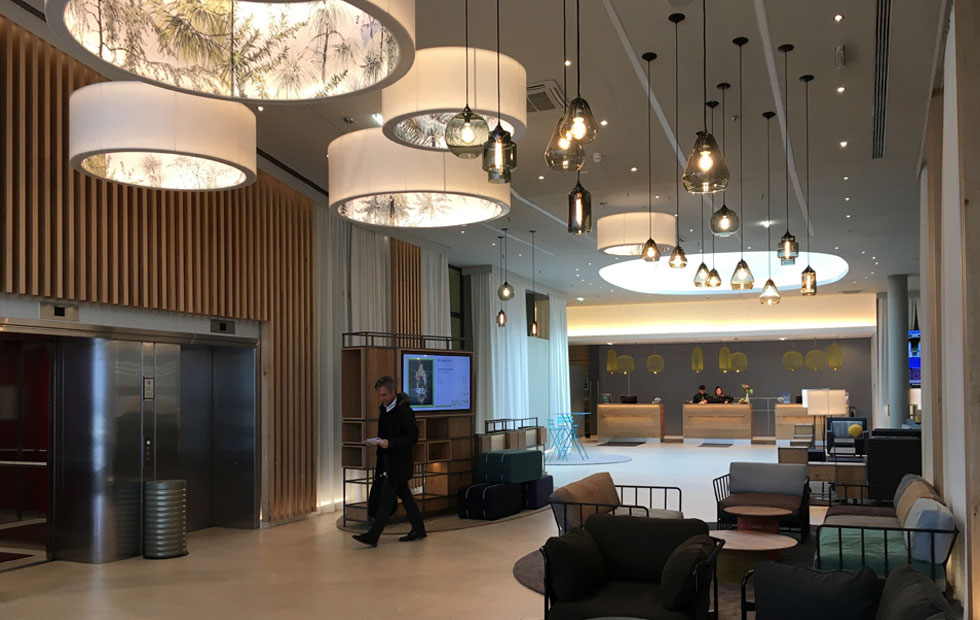
New technology is radically altering our interiors, all for the better, argues Steve Jones, co-founder of British furniture and lighting brand, Innermost.
Product: Core
Project: Hotel
Location: Vienna, Austria
Project and photo: BWM Architekten
“For years tech got in the way; since the first electrification of houses, interiors have been filled with trailing cables and routing things via nails right until recent times when the computer and the mass of AV gadgets in our living rooms took over.
I first started my career in the furniture industry designing office furniture for brands like Knoll and Vitra; back in the 80s and 90s, everything was about ‘cable management’ which really should have been called camouflage and control. When I look at modern office furniture I think today’s designers have it easy!
I’m now in lighting and there is little in a modern interior – other than the air we breath – that affects our view of a space more than light. Little more than 20 years ago domestic lighting had little choice and aside from a few very high-end brands, the most control you could get was a rotary dimmer. I remember when we first started Innermost and offered a dimmer unit on a product to a major UK retailer (who will remain nameless) I was told that it was a ‘luxury people won’t pay for’. Well 20 years later we are on the brink of a human-centric lighting boom and we now offer control systems that ‘people’ can control from their phones – and they love it. It’s changed not just the lights people choose but how they use them and even when.
That same technology being wireless has not brought excessive cabling and this means the new tech isn’t just the preserve of new builds; you could put it into a grade 1 listed building without negative impact; no nails to bang. More than that I can’t remember the last time I used a light switch in my own home, I just have the app open. Will we remove light switches? It would certainly make decorating a lot easier. My son who was given the app when as a 6 year old he was still scared of the dark does delight in turning the lights off whenever a guest goes into the toilet – for that reason so we won’t be getting e-locks in our apartment anytime soon; another area where the traditional copper and brass hardware has given way to tech.
I recall a report back when flatscreens were new that the demise of the cathode ray tube for brokers and bankers would free up 20% of all the office space in the city of London; dark predictions were made of empty office spaces and downward rents. That of course was ridiculous but in back to back desk layouts the idea that 20% of the space we had was dedicated to the CRT monitor was just something we’d got used to. It took a few years but the same thing then happened with LED TV’s in the home; our living rooms suddenly looked bigger. Now you can hang them on the wall and Samsung just showed a screen that ; a product that really is there when you need it.
Interior designers and architects now understand the issues and are seeing how they need to design to get the best; my feeling is that in the future we will not only choose materials based on how we need to route signals but that ‘data-flow’ analysis might become a thing. If it does then you read it here first. Simply we will require our designers to create spaces that allow data to move and things to be seen no matter where they are within the interior. I’m going to call it ‘Daflo’ analysis!
Remember just before cell phones boomed and there were 10 different phone companies all installing boxes on the streets and we all groaned at the impact; then cell phones meant all of that was scrapped and in a way, we cleaned up our streets a little.
After computers messed up our homes it was the turn of mobile phones to create cable tangles and the need for extension sockets to be trailed alongside chairs and all over offices. The first change we saw was that the USB socket was included in ever more products allowing us to charge but now wireless charging potentially means cables will be within furniture (again) but this time surfaces will be clean.”
For more from Steve Jones on Technology, Furniture & Lighting, follow him on LinkedIn.


